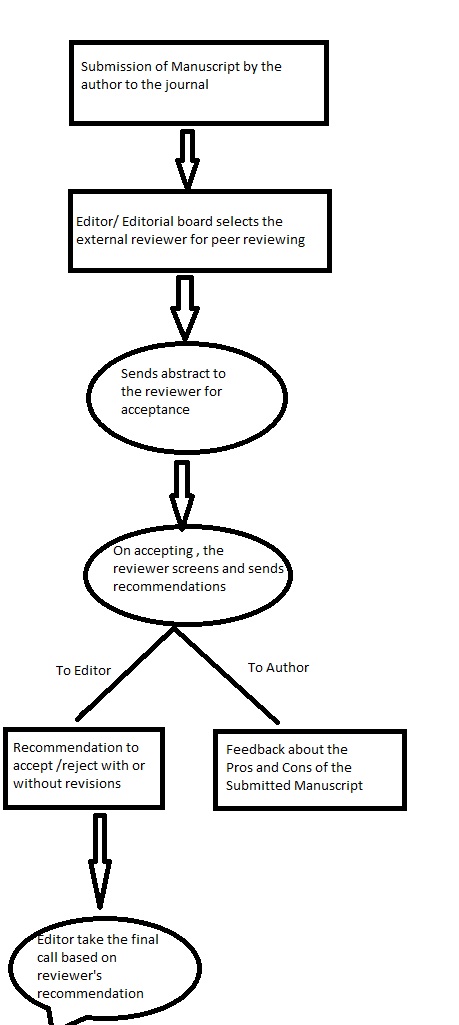Introduction
With the increased surge in Journals and researches happening all over, it is very essential to ensure that the correct information is propagated. The Peer review forms an important aspect of today’s research publication. Shortly, it is the screening of the submitted manuscript by two or more of the topic experts.
Background
Practically no historical accounts of the evolution of peer review exist. Biomedical journals appeared in the 19th century as personal organs, following the model of more general journalism.[1] Peer review originated with the Royal Society of Edinburgh in 1732 and subsequently was adopted by the Royal Society of London in 1752.[2] Several factors contributed to the widespread adoption of peer review across the physical, biomedical, and behavioral sciences after World War II, including increased federal support for research, dramatic growth in the research community, increased specialization among researchers with a concomitant demand for reviewer expertise, and intense competition for journal page space. However, editorial practices appear to have changed piecemeal, with each editor and journal rediscovering the process anew.[2]
Process
Role of a reviewer
Essentially, the reviewer serves two major functions. [3]
The first function is to judge whether the manuscript merits publication (usually after revisions) by providing a global rating—that is,
- “Accept,”
- “Accept Pending Revisions,”
- “Reconsider After Major Revisions,” or
- “Reject.”
The second role is to provide constructive criticisms for the authors, regardless of whether the manuscript is deemed acceptable for eventual publication.
As stated by Frederic G. Hoppin, Jr [4] , the task of the reviewer is to see what the authors have not seen: “The reviewer can be fully as helpful as an involved laboratory colleague or a visiting professor”
Requirements of good review
- Motivation – reviewing manuscripts is (almost universally) unpaid, volunteer work, and part of what we think of as a “culture of service” to the profession. [5]
- Subject Expertise – Reviewing a submitted research paper demands expertise in the topic and also sound knowledge on Research methodolgy and statistical methods.
- Positive criticism – The review should comprise of highlighting both postive and negative aspects and not mere fault finding tool. As generally said, treat the work submitted as how one expects his/her work to be treated.
- Commitment – It is not always easy to stay committed in a Volunteering job. completing the work within the stipulated time is of paramount importance. The published works on peer review process generally advocates Three hours for one review as spending more than three hours may not yeild any additional outcome. However a novice peer reviewer is expected to spend 8-12 hours initially. [6]
Merits & Demerits
Merits
- Reduces the burden of editor/ editorial board.
- Expertise of the specific topic to review results in best possible outcome.
- Multiple peer reviews provides deep insight about the research topic.
- In reviewing manuscripts, the reviewer gains access to invaluable bibliographies.
- Option to be updated on the field on expertise.
Demerits
The peer review process has been a matter of debate for the following reasons
- The authenticity of the expertise claimed by the reviewer is questionable.
- Extreme contradictions by the two various reviewers on the same manuscript makes editor/editorial board to struggle in making decision.
- Usually unpaid
- Blinded reviews makes the work of reviewer to get unnoticed.
- May cause delay in the process of publication as editor/editorial board has to decide depends upon the recommendation by the reviewers.
Resources
Online Course
Translating Critical Appraisal of a Manuscript into Meaningful Peer Review
Developed by: Cochrane Eyes and Vision Group
Articles
- ↑ Burnham, J.C. (1990). The evolution of editorial peer review. Journal of the American Medical Association, 263, 1323–1329.[abstract]
- ↑ 2.02.1 Suls J, Martin R. The air we breathe: A critical look at practices and alternatives in the peer-review process. Perspect Psychol Sci. 2009, 4:40–50.
- ↑ James M. Provenzale, Robert J. Stanley; A Systematic Guide to Reviewing a Manuscript ;Special Article, Commentary; AJR:185, October 2005, DOI:10.2214/AJR.05.0782
- ↑ Frederic G. Hoppin, Jr. “How I Review an Original Scientific Article”, American Journal of Respiratory and Critical Care Medicine, Vol. 166, No. 8 (2002), pp. 1019-1023.
doi: 10.1164/rccm.200204-324OE - ↑ Lovejoy T, Revenson T, France C. Reviewing Manuscripts for Peer-Review Journals: A Primer for Novice and Seasoned Reviewers. ann behav med. 2011;42(1):1-13.DOI:10.1007/s12160-011-9269-x
- ↑ DAVID MOHER, ALEJANDRO R JADAD; How to peer reviewfckLRa manuscript ;PEER REVIEW IN HEALTH SCIENCES .


